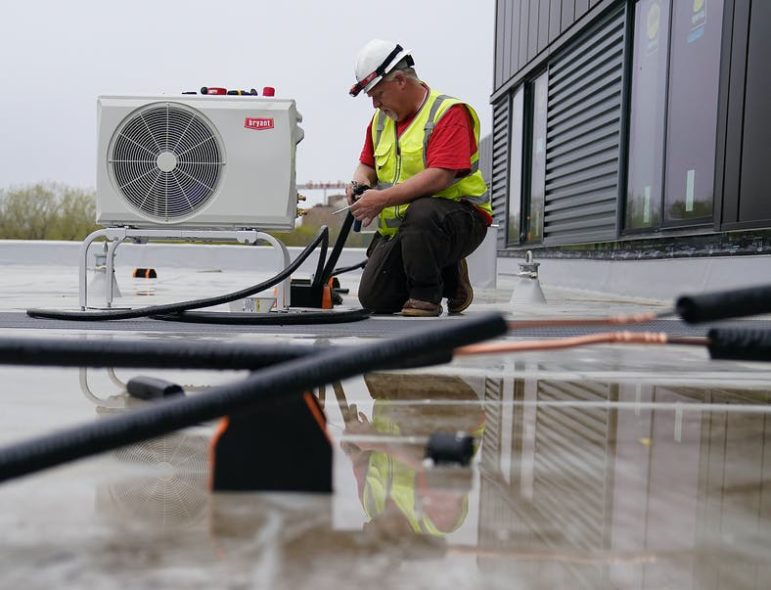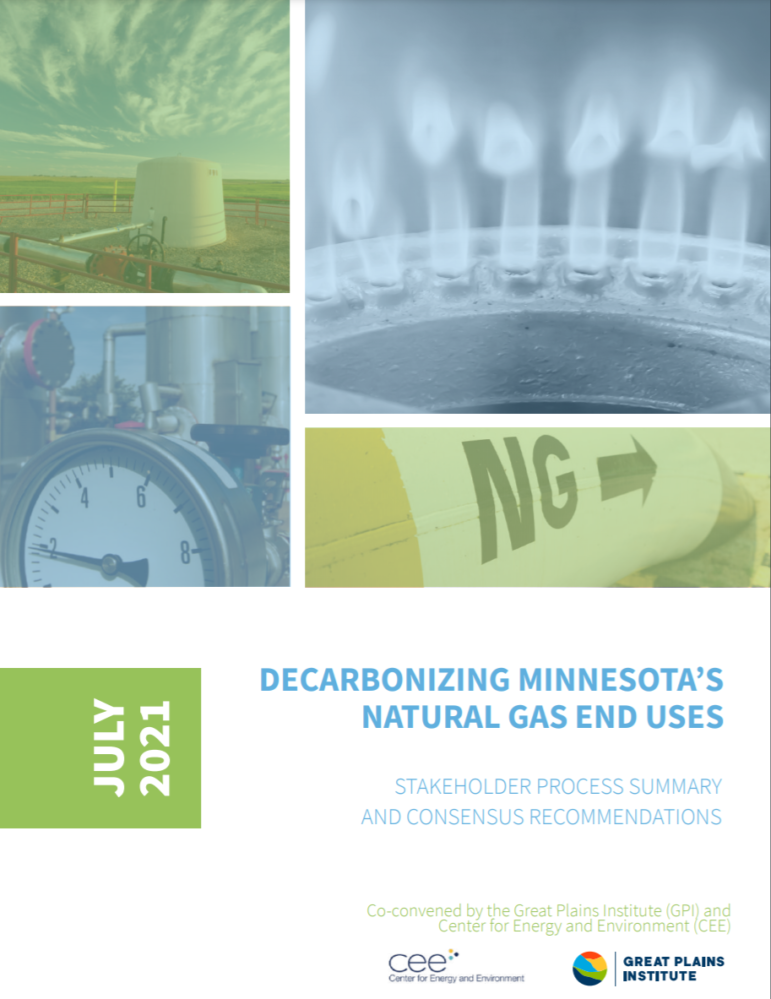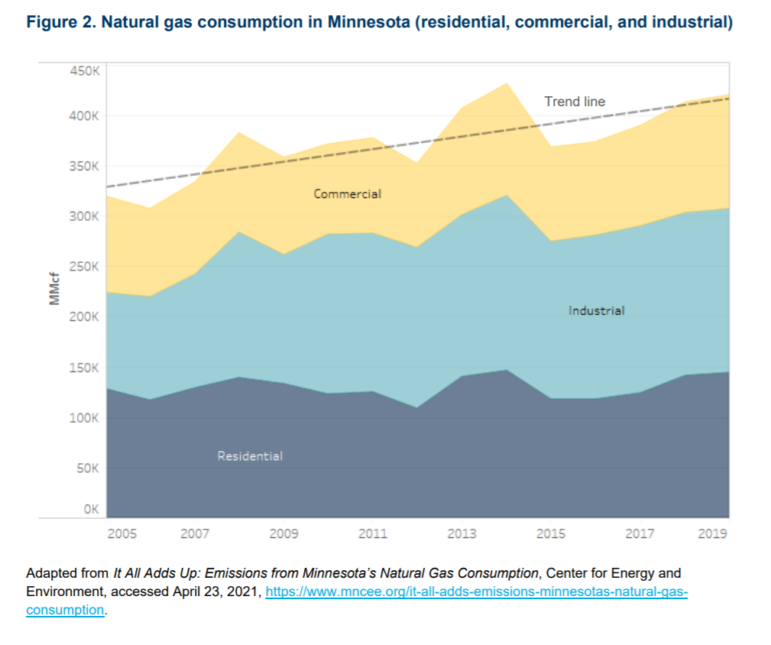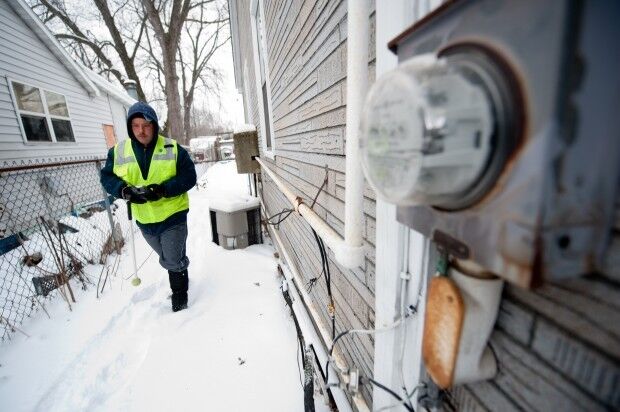
Here in Minnesota, more than 63 percent of homes and buildings depend upon fossil gas—also known as natural gas—every day for cooking, heating our shower water, drying clothes, and warming the spaces we frequent. But there is strong and growing evidence that using fossil gas poses significant risks, including carbon monoxide poisoning, elevated nitrogen dioxide (NO2) levels often exceeding both indoor guidelines and outdoor standards, fires, and explosions. Plus, fossil gas is projected to lose its economic advantage relative to clean energy within 15 years. That means any new investments made in natural gas infrastructure today may result in increased consumer costs down the road, whereas the decreased costs and improved performance of renewable energy sources make carbon-free energy a more cost-effective and reliable option.
While widespread economic, policy, and technology changes have prompted Minnesota-based corporations and businesses as well as the public to begin urging for decarbonization, our state’s emissions from fossil gas consumption only continue to rise. In fact, state greenhouse gas emissions are now increasing most rapidly in the industrial and building sectors, primarily as a result of on-site combustion of fossil gas. At this critical time in history, when both the Intergovernmental Panel on Climate Change (IPCC) and International Energy Agency (IEA) have determined that we must achieve carbon neutrality economy-wide by 2050 to avoid the worst impacts of climate change, Fresh Energy has remained a key figure in the push to decarbonize Minnesota, working at the agency, legislative, and community levels alongside our partners and other key parties to advocate for decreased reliance on fossil gas within Minnesota.

For nearly two years, a broad mix of stakeholders—from natural gas and electric utilities to natural gas consumers to workforce advocates to clean energy advocates and implementers—has been convening to discuss methods for decarbonizing Minnesota’s natural gas end uses, with final recommendations published in the report “Decarbonizing Minnesota’s Natural Gas End Uses.” Fresh Energy played a central, guiding role on the steering committee for this report, alongside the City of Minneapolis, Xcel Energy, and CenterPoint Energy. Center for Energy and Environment (CEE) and Great Plains Institute (GPI) co-convened the group and co-published the report.
Decarbonization pathways

As a means of exploring methods and parsing potential solutions for drastically reducing or eliminating Minnesota’s fossil gas emissions, stakeholders discussed a handful of potential scenarios, or pathways, that could help the state decarbonize its fossil gas end uses by 2050. Per the report, stakeholders and the steering committee selected the following scenarios to explore:
- High electrification—A scenario in which nearly all buildings in Minnesota switch to all-electric and are heated with air-source heat pumps, with electric resistance backup heating. Existing buildings are retrofitted to achieve high levels of energy efficiency, and new buildings are constructed to be all-electric. The industrial sector is electrified where technically viable, and, where needed, fueled by decarbonized gas, like hydrogen, renewable natural gas (RNG), and/or synthetic methane.
- Electrification with gas backup—In this scenario, buildings are heated primarily by air-source heat pumps but keep their gas connection as a form of backup heat during the coldest hours of the year, with fossil gas gradually replaced by a blend of RNG, synthetic natural gas, and/or hydrogen. Existing buildings are retrofitted to achieve high levels of energy efficiency, new buildings are constructed to be all-electric, and industry is electrified where technically viable and fueled by decarbonized gas, like hydrogen, RNG, or synthetic methane, where needed.
- High decarbonized gas with dedicated hydrogen for industry—Buildings continue to be heated primarily by gaseous fuels, with fossil gas gradually replaced by a blend of RNG, synthetic natural gas, and/or hydrogen. Buildings achieve high levels of energy efficiency through retrofits. Industry is supplied with dedicated hydrogen produced using renewable electricity.
- Ground-source district energy analysis—In this supplementary analysis, which was paired with the high electrification scenario, the heating load in all new construction buildings is served by ground-source district energy systems, representing 27% of buildings by 2050. The analysis was run in order to determine the potential for ground-source district energy systems to reduce electric peak impacts.
Potential solutions
While stakeholders did not agree on what decarbonization pathway was best for the state to adopt, they did agree that meeting and exceeding Minnesota’s greenhouse gas reductions goals will require immediate, definitive departure from the state’s current trajectory of fossil gas use in buildings and industry toward a pathway that will lead to a significant amount of decarbonization of fossil gas end uses. To that end, stakeholders proposed a set of 25 consensus recommendations for what can and should be done now to develop that pathway.

No matter how we act to decarbonize, one thing is clear: the time for action is now. To avoid the worst economic and public health impacts of climate change, the decarbonization pathway we choose to travel today must be one that gets us to carbon-neutral by 2050, and then carbon-negative thereafter. As this report indicates, whatever decarbonization pathway we embark upon will be expensive, requiring the passage of enabling policy and financing. This transition should not be born on the backs of individual ratepayers, building owners, and residents—something Fresh Energy is advocating for throughout our policy work. Moreover, the investments we make today should be carefully allocated to facilitate an equitable energy transition, especially for under-resourced communities who will be most impacted by both the transition and climate change, and durable markets that will support the workforce of the future.
Fresh Energy supports a decarbonization pathway that advances electrification paired with energy efficiency in the building sector, deploying ground-source district energy systems to mitigate peak electric demand, and a mix of electrification and alternative gaseous fuels, like RNG, synthetic methane, and hydrogen, in the industrial sector. As Fresh Energy evaluates decarbonization solutions for the future, we are taking a multi-sector approach that recognizes that fuels and technologies will need to be deployed carefully to achieve science-driven emissions reduction goals in time. Given that alternative gaseous fuels are costly and the feedstocks and production energy that determine their scalability are limited, we believe that Minnesota will achieve the most cost-effective and significant carbon reduction value by pairing alternative gaseous fuels with end-uses that will be technically impossible and cost-prohibitive to electrify, such as in the industrial sector.
From Fresh Energy’s perspective, deep decarbonization is highly viable through the process of electrification, especially across residential and commercial buildings. We see the building sector as ripe for electrification and have serious concerns that utility deployment of alternative gaseous fuels in buildings will slow the pace of electrification and progress on greenhouse gas reduction, ultimately increasing investment in existing carbon-intensive natural gas infrastructure systems, much of which will outlive our 2050 climate goals, and limiting deployment of alternative gaseous fuels in other sectors of the economy that are impossible to electrify.
Fresh Energy’s lead director of energy transition Dr. Margaret Cherne-Hendrick says, “Achieving and then exceeding Minnesota’s greenhouse gas reduction goals to avoid the worst effects of climate change will require substantive and expeditious action informed both by science and those communities and workforces most impacted by the transition away from natural gas.” She adds, “We know that decarbonization will require investment and enabling policy alongside regulation to advance markets. This is our opportunity to achieve not only carbon neutrality by 2050, but also net-negative emissions after 2050. As a first step, our recommendations make clear that we must reimagine the regulation of our natural gas and electric utilities to support innovations to catalyze a decarbonized economy.”
Minnesota’s natural gas future
To achieve a carbon-neutral economy, we need to move beyond using fossil gas for home heating, industrial processes, and other uses. The recent passing and signing into law of the Natural Gas Innovation Act (NGIA)—a bipartisan component of the Omnibus commerce, climate, and energy policy and finance bill at the Minnesota legislature this session—paves the way for Minnesota to take definitive action on reducing climate change and pollution-causing emissions. The NGIA creates a pathway for gas and dual-fuel utilities to explore opportunities to shift from fossil fuels to wind, solar, and other zero-carbon energy sources, decarbonizing service across their territories. You can read Fresh Energy’s full statement on the NGIA here.

Importantly, a provision in the NGIA requires the Minnesota Public Utilities Commission (PUC) to open a “Future of Gas” docket by August 1, 2021, to evaluate changes to natural gas utility regulatory and policy structures that will be needed to meet or exceed Minnesota’s greenhouse gas emissions reduction goals. Fresh Energy sees a Future of Gas docket as integral to increasing public transparency into gas utility investments and programs as well as reimagining the regulatory framework that governs gas utilities in a deeply decarbonized economy. In order to substantially reduce our state’s greenhouse gas emissions and stay on the path to electrification, we must pilot and implement programs to maximize consumer savings, enhance electrical grid operation, ensure energy access and equity by prioritizing electrification in under-resourced and other impacted communities, and drive a clean energy economy by recruiting, training, and investing in skilled labor. That means our state is approaching some major decision points that will set the trajectory for future gas use in Minnesota, and Fresh Energy will continue to show up alongside a diverse coalition of partners to engage in this issue via the Future of Gas docket.
As demonstrated by the work of the coalition in the report, Minnesota has an opportunity to act now to substantially reduce emissions and meet and exceed its greenhouse gas emissions reduction goals at the pace and scale the climate crisis requires. Work is already underway at Fresh Energy to form and mobilize a diverse coalition of partners to engage in the Future of Gas docket and we’ve expanded our Energy Transition team to ensure we can dedicate the time and resources this issue requires. Fresh Energy is excited to mobilize a diverse coalition of partners to maximize the major opportunities for decarbonization presented by the Future of Gas docket and drive equitable, transformational change in Minnesota that positions our state as a leader among other cold climate states.
